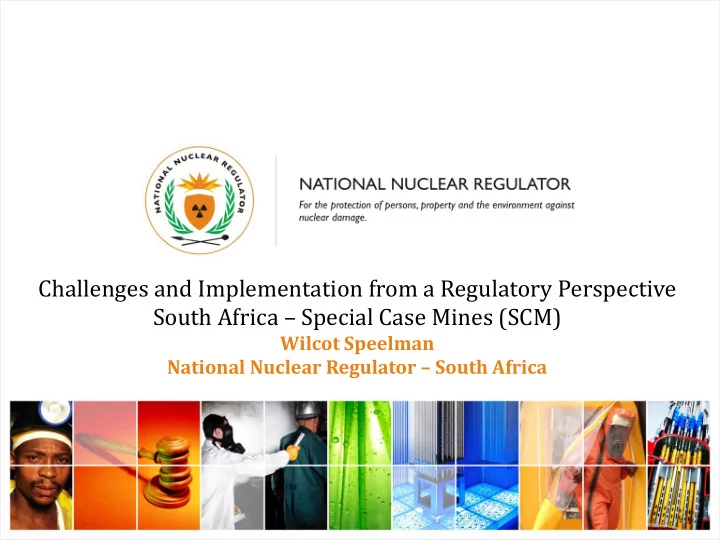

Challenges and Implementation from a Regulatory Perspective South Africa – Special Case Mines (SCM) Wilcot Speelman National Nuclear Regulator – South Africa
LEGISLATIVE REQUIREMENTS (i) Revised
LEGISLATIVE REQUIREMENTS (ii) DOSE LIMITS - SSRP ANNEXURE 2 The occupational exposure of any worker shall be so controlled that the following limits are not exceeded: • The occupational exposure of any worker shall be so controlled that the following limits are not exceeded an (average) effective dose of 20 mSv per year averaged over five consecutive years, General Dose Limits 1.1.1 • a (maximum) effective dose of 50 mSv in any single year, General Dose Limits 1.1.2 • in special circumstances, provided that radiation protection in the action has been optimised as required by 4.5.1 of the regulations but occupational exposures still remain above the dose limit in 1.1.2 above , the Regulator may approve a temporary change in the dose limit subject to the agreement of the affected employees, through their representatives where appropriate, and provided that all General reasonable efforts are being made to improve the working conditions to the point Dose Limits 1.1.5 where compliance with the dose limits can be achieved. This temporary change shall not exceed 5 years and shall not be renewed.
MINING AND MINERALS PROCESSING – SPECIAL CASE MINES RADIATION EXPOSURES IN UNDERGROUND MINES • Highest annual effective doses occupationally • From 222 Rn and particulate progeny inhalation REASONS • Uranium and thorium in most gold reefs in South Africa • Dynamic nature of underground mining • Challenges with ventilation controls • Unexpected consequences from opening “Old Worked Out” Areas HISTORY • Radiological Exposure and Radioactive Material were not regulated in the NORM industry before 1993 . • Radon dose conversion conventions at the time. • Biggest concern was Radon Exposure and the Control thereof. DEFINITION of SCMs • Potential radiological exposure of 1.7 mSv/month or above , • Projected annual radiological dose exceeding 20 mSv/a
OPERATIONAL MONITORING FOR SCMs NNR’s response had been consistent with: • Identify all working areas where workers could be exposed to doses above the dose limit , • Remove all workers whose annual projected could exceed the 50 mSv/a , • Supply the NNR with mechanisms by which compliance with occupational radiation dose limits will be achieved. Remedial Plans would include: • Prevent contaminated (used) air to be recirculated in current working places • Ventilation of the underground workings must provide for: a) installation of ventilation control systems in stopes, booster fans b) dedicated return airways (RAW) c) Sealing programmes - Sealing off all old working areas to prevent air contaminated with 222 Rn entering current working areas. d) introduction of fresh air into problem areas
IMPROVEMENTS • What did the picture look like? • How does the picture look like now? In 2002/2003 In 2003/2004 In 2012/2013 Reporting Year, Reporting Year, Reporting Year, 1133 Workers 324 Workers INTERVENTIONS 0 Workers Exceeded 50 Exceeded 50 exceeded 50 mSv/a mSv/a mSv/a All Workers < 20 mSv/a Average (Sec 1.1.1 SSRP Annex. 2) - Challenges Working Groups Currently 7 Mines - Implementation were established Classified as SCMs - NNR Inspections
CHALLENGES The Following On-Going Problems are Noted: • There are still workers in the 20 to <50 mSv/a exposure grouping (s). • Some ventilation systems are not fully optimised. • Strategies for sealing programmes have not been fully realised. • Integrated Time and Attendance Systems not adopted by all stakeholders – some loopholes in systems where T&A systems are deployed. • A great number of the workforce makes up “Roaming” workers deployed on levels in shafts with varying degrees of 222 Rn levels. • Timeously identification of work areas/levels with high 222 Rn activity concentrations. • Implementation of Worker RP Programmes. In the Near Future: • Publication of updated Rn Dose Conversion Factors • Decision on Adoption of Rn DCFs (Country) • Possibility of an Increase in Special Case Mines
CONCLUSIONS • The need for adequate protection from complex exposure scenarios in the workplace bring significant challenges to the fore • The need to mine and produce more product (e.g. Au, U, etc.) enhances the risks • The response(s) to the challenges are highlighted: Regulatory Inspections and Audits Commensurate with Exposures at the Facility Enforcement • The off-set for Cost and Effort that go into Implementation is measured - ALARA • Role of the Regulator vs Role of the Operator in Finding Solutions to the Problems • Appropriate Response in Legislative Revisions (where gaps exist) • Key Focus should be Continual Improvement
FIN THANK YOU Wilcot Speelman - Senior Specialist: Environment & Radiation Protection National Nuclear Regulator – South Africa Eco Glades 2 Block G, 420 Witch Hazel Avenue, Highveld, Centurion PO Box 7106 Centurion, 0046 c: +27 (0) 83 744 7492 - t: +27 (0) 12 674 7102 - f:+27 (0) 86 589 0368 e: wjspeelman@nnr.co.za I w: www.nnr.co.za
Recommend
More recommend